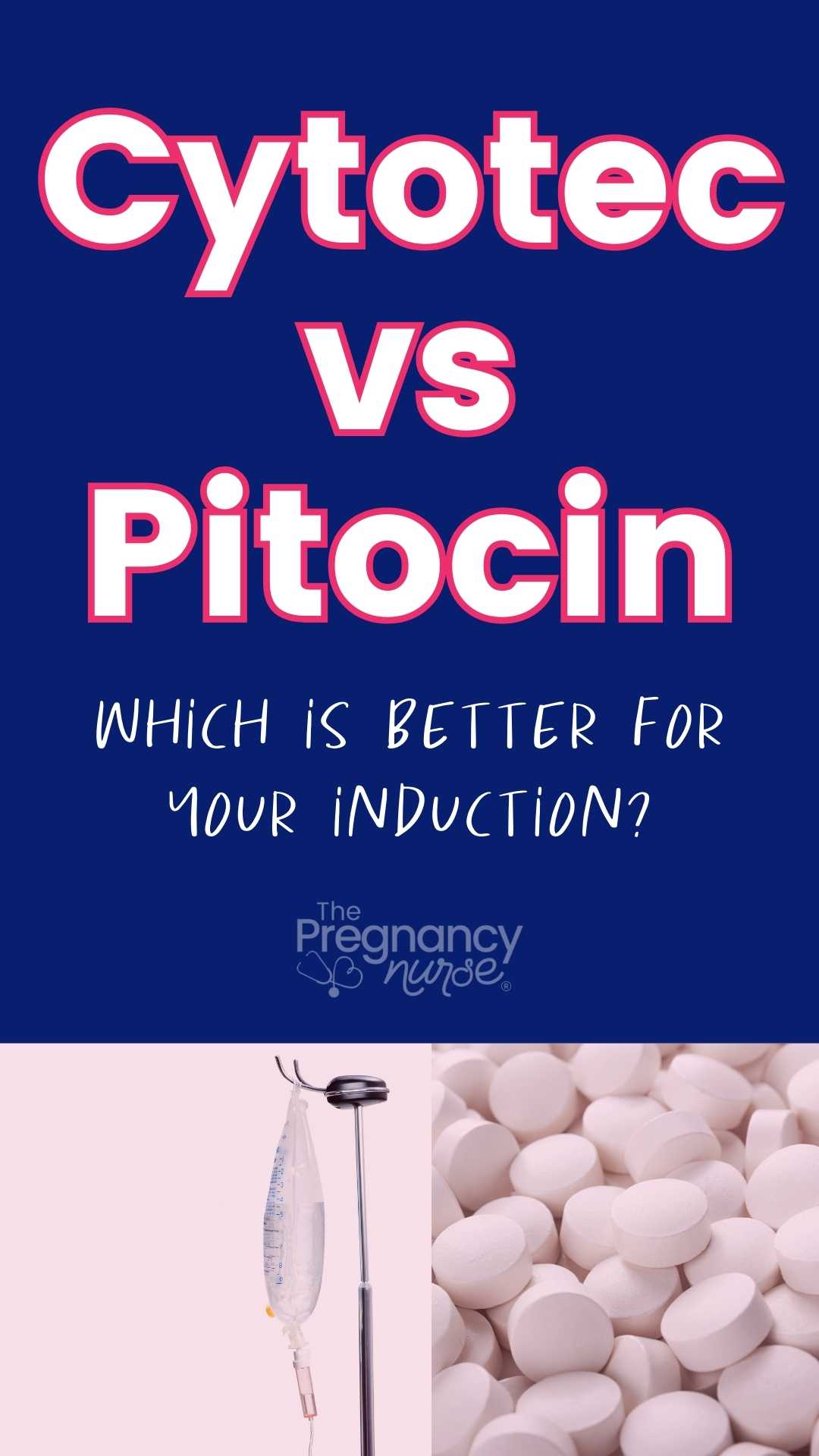👋 I’m so glad YOU are here. Are you looking to also get your partner prepared? This is for BOTH of you. Couples just love it and I know you want to both feel prepared!
Cytotec (also known as Misoprostol) and pitocin are different agents that are used for an induction of labor. In this article we will review how they’re given, what instances they’re used and how they work in your body.

But, how do I know so much about inductions?
Hi — I’m Hilary — The Pregnancy Nurse 👩⚕️. I have been a nurse since 1997 and I have 20 years of OB nursing experience, I am also the curly head behind Pulling Curls and The Online Prenatal Class for Couples. 🩺 I have helped with thousands of inductions and have seen how they work for myself in lots of different patients, so you might call me an expert in this.
What Are Pitocin and Cytotec?
Pitocin and Cytotec are drugs used to induce labor in women (or start labor). Most often this is those who are past their due date or are experiencing complications.
Pitocin is a synthetic version of the hormone oxytocin, which causes contractions in the uterus. Cytotec is a medication that softens the cervix and stimulates contractions (considered a cervical ripening agent). Both drugs are used to initiate and/or speed up the labor process in pregnant women.
However, both medications increase your risks in labor. Although both Pitocin and Cytotec may be available to speak to about inductions, it is important to carefully consider the potential risks before consenting to their use.
And inductions are more complicated than “regular” labor, so it’s more important to understand what to expect in labor, so I recommend this.
What is Cytotec used for in pregnancy?
Cytotec is a medication that is commonly used to induce labor or to ripen the cervix in women who are pregnant.
The use of Cytotec has become increasingly popular due to its ease of administration, low cost, and its effectiveness in inducing uterine contractions.
Cytotec is a prostaglandin that works by stimulating contractions in the uterus and softening the cervix, which can lead to the induction of labor. This can be a viable option for women who are facing complications during pregnancy, such as preeclampsia, gestational diabetes, or decreased fetal growth, all of which can lead to the need for early delivery.
A labor induction with misoprostol is done when you are less than 3 cm. It is used for people who’s cervix is not very “ripe” for labor, so we use it to get contractions started and open up your cervix to about 3 cm. Although some people will continue in labor on their own with just cytotec, most people will need pitocin to keep labor progressing.
I have a whole post on how Cytotec is given in an induction.
Most often your cervix is measured using the bishop score. I talk about that in my post on when your doctor will induce you.
How is Cytotec Given
One of the biggest benefits of cytotec is that it can be given in several ways:
- Vaginal — placed behind the cervix at the far end of your vagina (called the fornix)
- Oral — taken like a pill
- Buckle — place the pill between your gums and your cheek
- Sublingual — placed under the tongue.
It can be nice to have several ways to give it. With the vaginal placement, although you’d need to do a cervical exam before giving the medication, it can make the tissues in the vagina what we call “friable” — it just irritates them, and makes the vaginal checks more painful, and those tissues more sensitive.
With the oral route, you need to watch how food may change how the medication is absorbed by your body.
I personally like the buckle or sublingual options as they don’t have these issues (other than an annoying aftertaste in your mouth, which you can swish with water once the pill is dissolved).
Most hospitals only require you to be monitored for the first 1-2 hours after the cytotec is given, but then you have an hour or so after that which you can get up and move, shower, eat — that’s one of my favorite things about it, and I always encourage patients to get up and move during that time. Movement during labor is super important.
Pro tIp: Both cytotec and pitocin must be given in the hospital, in labor and delivery. They are not given in birth centers or with a home birth due to possible complications.
Is Cytotec FDA approved for labor induction?
It is not. It is used “off label” to induce labor. On some units you may be asked to sign a separate consent to OK it’s use since it’s “off-label”.
Cytotec is actually a medication they give to prevent and treat stomach ulcers (and it is FDA-approved for that).
However, it has been used since before I started in 2000, and several studies have proved its effectiveness, and how it decreases the time in labor for those being induced.
You should be aware that LOTS of drugs are used “off-label” and that isn’t unusual at all.
Personally, I have used cytotec hundreds of times. When used carefully I am a big fan of it and how it can soften a cervix before starting pitocin. If you skip the cytotec process, the induction can just take longer and be more painful. This Cochrane review shows that it results in fewer c-sections than Pitocin alone.
Pro Tip: Cytotec is often used in abortions as well (initiating contractions for a pregnancy you’re terminating). I think this has tainted the view of cytotec in general, and may be why so many people don’t like it (and perhaps why the FDA has been so long to OK it for induction of labor, even though we have used it for probably close to 25 years.
Hilary Rant: I also think that sometimes meds that are cheaper and easier to store and use than their more expensive counterparts don’t get approved by the FDA. Seriously, Cytotec is like a quarter, and Cervidil (which is approved for induction of labor) is hundreds of dollars (and doesn’t prove to be any more effective or risky).
BTW, facing an induction — check out my best tips on how to prepare for an induction of labor.
What are the risks of Cytotec?
The main risk is a chance of uterine rupture (which is a true obstetric emergency), or contractions so frequent it isn’t good for the baby (called tachysystole).
Pro tIp: When your uterus contracts, less blood gets to the baby via the placenta. So, it is important for us to keep contractions at a safe level as we are initiating them with the medication (any induction agent can cause this).
Cytotec can lead to an increased risk of complications, such as a higher likelihood of needing cesarean delivery or excessive uterine contractions. Therefore, it is important to use Cytotec only for medically necessary reasons and under the guidance of a qualified healthcare professional.
How is Pitocin used for in pregnancy?
Pitocin is a synthetic form of the hormone oxytocin and is frequently used in pregnancy to induce contractions.
This medication is given to encourage labor to start, most often if a woman’s pregnancy has progressed beyond her due date or if there are concerns about the health of the mother or the baby.
Pitocin can cause contractions to begin and become more frequent, which can lead to vaginal delivery. In cases where labor needs to be induced, the dosage of Pitocin is gradually increased until the desired effect is achieved (usually contractions every 2-3 minutes). However, it should be used carefully because too many contractions can put stress on the fetal heart causing fetal distress (just like cytotec) which may require an emergency C-section to deliver the baby safely.
Overall, Pitocin is a valuable drug in pregnancy that can be used effectively to induce labor if needed, but with caution.
Hospitals are required to have very specific guidelines about how pitocin is administered, and what type of monitoring needs to be done. For instance, you will likely need continuous fetal monitoring, with an RN assessing your contractions and baby’s heart rate every 15-30 minutes. The RN can increase the pitocin by 2 mili-units every 30 minutes until contractions are every 2-4 minutes and opening the cervix.

What are the risks of a Pitocin induction?
Although Pitocin can be effective in promoting labor, it is not without risks. One of the biggest risks of Pitocin induction is that it can cause hyperstimulation of the uterus, which can lead to fetal distress and even death in some very rare cases.
Pitocin can cause contractions to become too strong and frequent, which can lead to a prolonged labor and increased pain for the mother. Other risks associated with Pitocin induction include infection, hemorrhage, and a higher risk of C-section delivery.
Therefore, it is important for women to carefully weigh the risks and benefits of Pitocin induction with their healthcare provider before deciding whether or not to undergo this procedure.
Why Are Labor-Inducing Drugs Used by Doctors?
Labor-inducing drugs, such as Pitocin and Cytotec, are used by doctors to help stimulate contractions in the uterus and initiate labor. These drugs are typically used when delaying delivery poses a risk to both the mother and the baby.
Most often this is due to:
- Preeclampsia
- Gestational diabetes
- Small baby
- Large baby
- Too much or too little amniotic fluid
- Overdue (normally past 41 weeks gestation)
Women can also make the choice to be induced (with no medical reason — this is called an elective induction) once they are 39 weeks and if the hospital has capacity for it. The Arrive Trial showed that an elective induction at or after 39 weeks was as safe as waiting. It is controversial which is why I made a bonus video in here to talk more about how it may be used to to shape your own choice in your pregnancy.
Are there other induction agents besides Pitocin and Cytotec?
There are! Providers also use Cervidil or less often, prostin gel. But, they both come with similar risks. The biggest benefit of Cervidil is that it can be removed (it’s sort of like a hormone-infused tiny tampon) at any time if labor gets to be too much.
Cervidil is expensive and can be harder to place and get good absorption by the birth canal, which is why Cytotec is used more frequently.
Which is safer, Pitocin or Cytotec?
Both medications come with risk, but they should be used at what they are best for:
Cytotec is good to get your cervix up to 3 cm, and Pitocin is good to progress you from the 3 cm until baby is born.
There are specific circumstances (most often like a previous uterine surgery, like a cesarean section) in which Cytotec can’t be given, and obviously if an induction needs to happen, Pitocin can be used instead.
I see that lawyers are all over this topic about birth injuries, but they are rare with an appropriately consented induction of labor. But, it is important that you carefully consider your options before being induced.
Learning to communicate with your team, as well as having reasonable expectations of your induction is key in having a great birth. The Online Prenatal Class for Couples prepares you for BOTH of those things. It has a whole chapter just on inductions to get you prepared!
Or, if you are just looking for information on inductions, come join me in my quick class Inductions Made Easy where I make inductions easy to understand!









 When Can I Get a Labor Epidural?
When Can I Get a Labor Epidural?
